Right in line with Independence Hall, the Liberty Bell Center, and the Independence Visitor Center is the National Constitution Center. This modern museum nicely ties together the history of the area and is a great overview of how the United States is governed. I visited here after seeing the first two locations and the Ben Franklin Museum, so you can fit a lot into a touring day of historic Philadelphia. And even though it’s a large building, it only took me about an hour and a half to tour, so it’s not overwhelming by any means.
National Constitution Center
I like that the National Constitution Center has a clear path to follow, more or less. The experience starts with a moving theatrical presentation, which empties into the main exhibit space. Then when you exit that area, the next big exhibit hall is just around the corner. You find the two newest exhibits on your way out, one leading right into the other.
Of course, you can do each space in any order you wish, but the above makes the most emotional sense. (I like to go from general to specific.) But if the theater show isn’t starting soon, you might want to do the first-floor exhibits in the meantime.
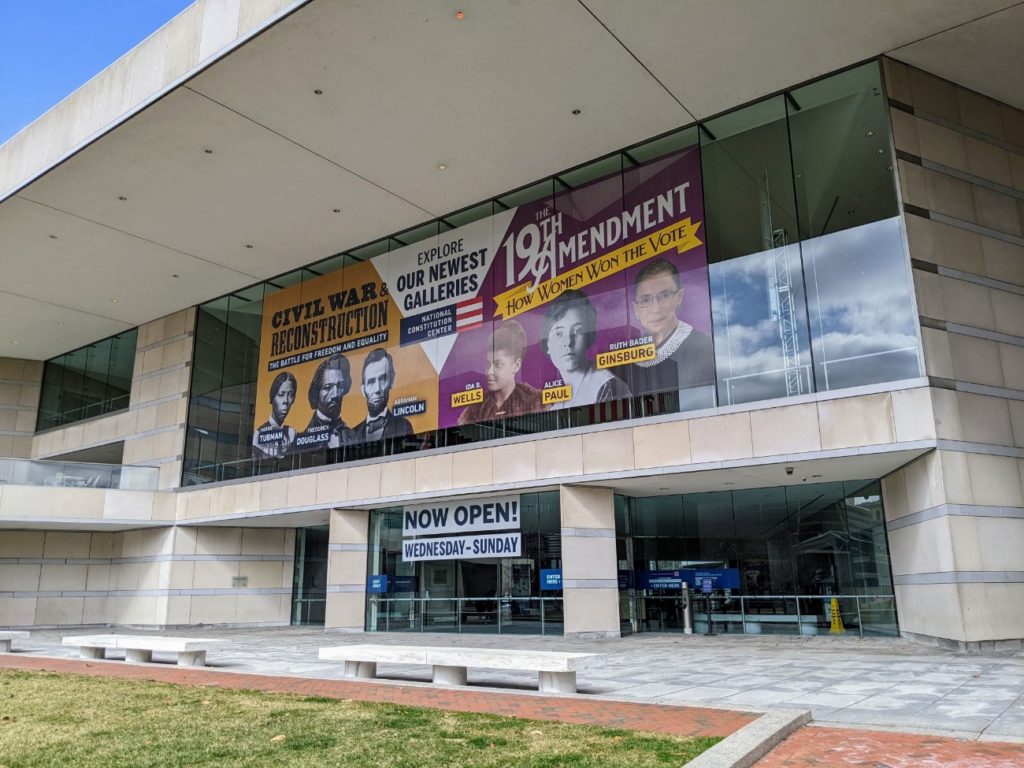
Lobby
When you enter the National Constitution Center, you enter into a huge sun-filled glass lobby. Ticket takers at a kiosk scan your pre-purchased ticket, though I don’t see anywhere where that is required, so I assume they will also take payment. They don’t look like they are set up for cash, however, so it might be cards only.
Once you get your admission wristband, take a look around the lobby. To your right is a large gift shop. To the right is a train station-style information desk. Behind that is a glass wall with presidential portraits. Above hangs flags from every state in the union. During my visit, a small stage and an activity table with coloring pages were set up for Black History Month. Around the right behind a large staircase are bathrooms and an elevator and a large eagle statue. A door in the back left corner leads to the newest galleries on Reconstruction and the 19th Amendment, covered below.
Freedom Rising
At the center back of the lobby is the entrance to Freedom Rising. The 17-minute show plays every half hour (or every hour, depending on where you look on the website. It probably runs less often in the off-season, more often in the summer.) Inside is a cool blue circular theater, narrow and tall. The multimedia presentation is a moving meditation on “We The People,” the starting words of the U.S. Constitution and features a live actor, rousing music, and projections pretty much everywhere. When it’s over, you exit at the top of the theater, on the second floor. (Those unable to do stairs can take an elevator to the top for both the show and the rest of the exhibits.)
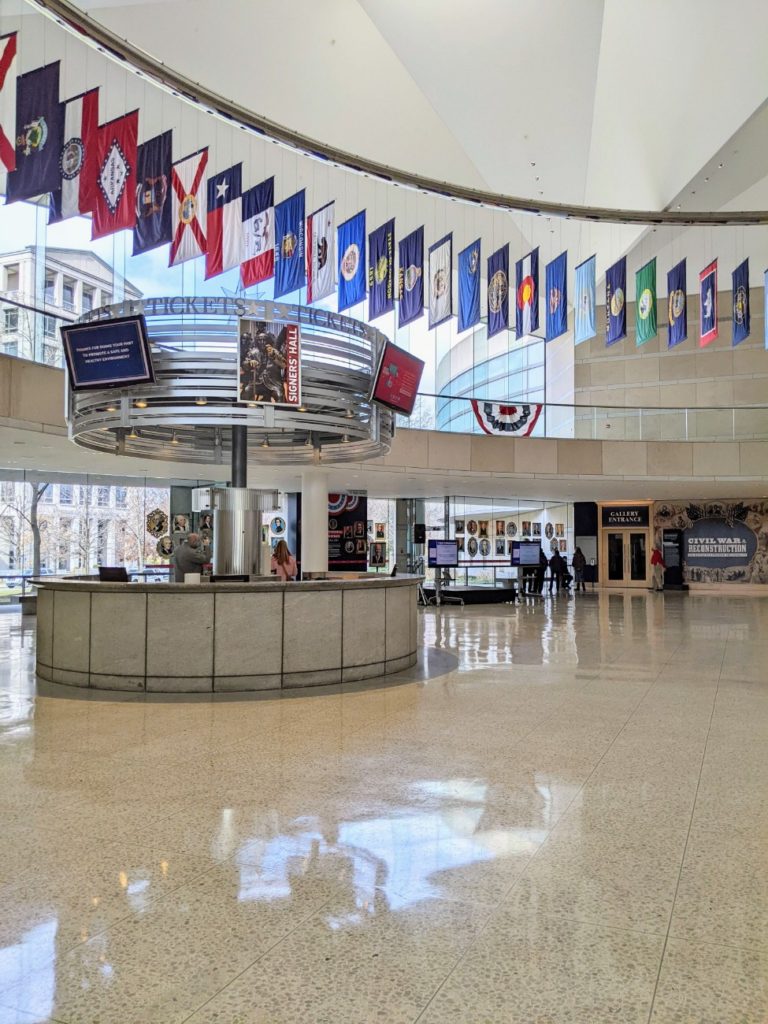
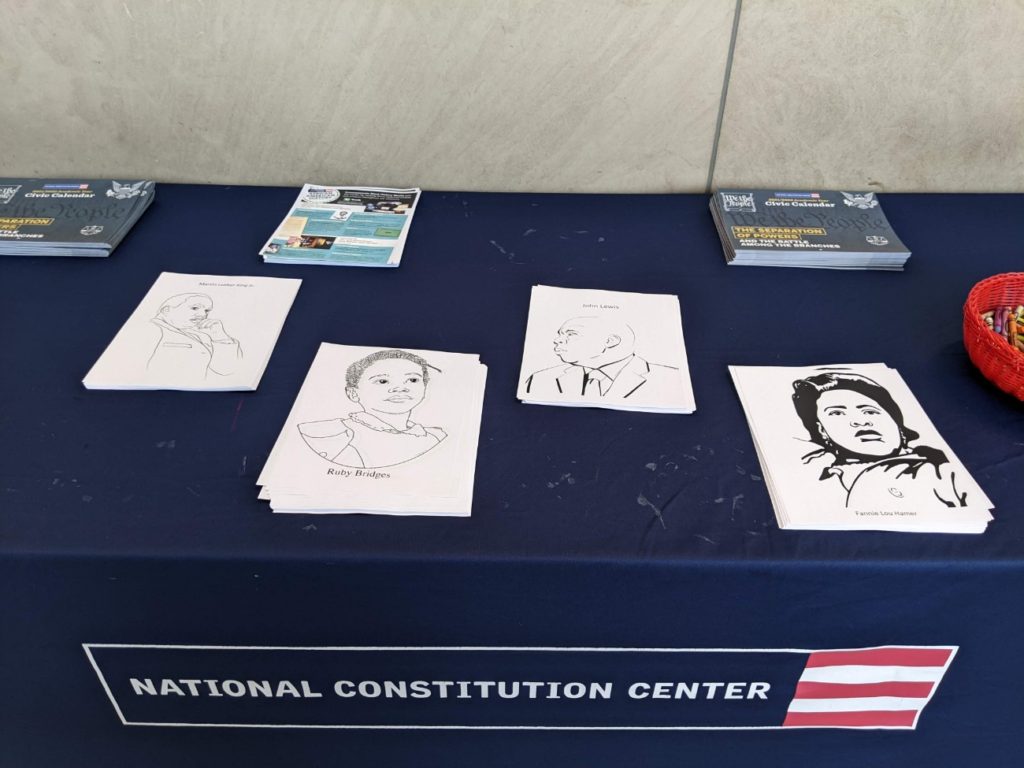
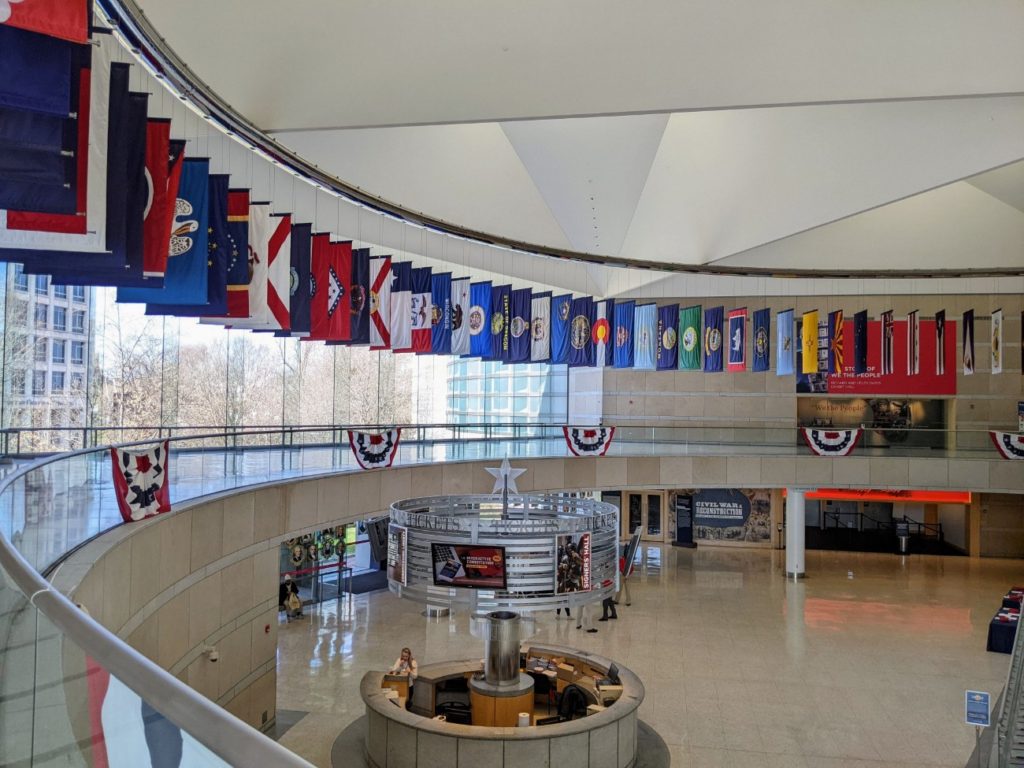
The Story of We The People
When you exit the theater, you face a wall with the Constitution’s “We the people” preamble and a guide that directs you to move clockwise around the circular exhibit room. The interactive space takes you through history, from the legal origins of the Constitution through the balance of branches of government and the influence of laws on infrastructure and modern life.
There is an outer wall with more historical artifacts and immersive nooks that activate when you step into them. In the middle, you can vote in a voting booth, with anonymous results on a screen above. Models representing the three branches of government – executive/the White House, judicial/the Supreme Court, and legislative/Congress – physically balance each other out on a teeter-totter. Sit in a jury, or at congressional desks, or swear yourself into executive office.
One part I wish was expanded is a touchscreen area called the “American National Tree.” It features six touchscreens highlighting “about 100 citizens who have shaped America’s constitutional history.” And if you stand back, whenever one of those citizens is chosen, they light up on a “tree” of screens above. It’s right at the beginning of the circle and is the first thing most people flock to when everyone exits the theater. It might be worth going all the way around the circle and revisiting it at the end when it’s not so mobbed.
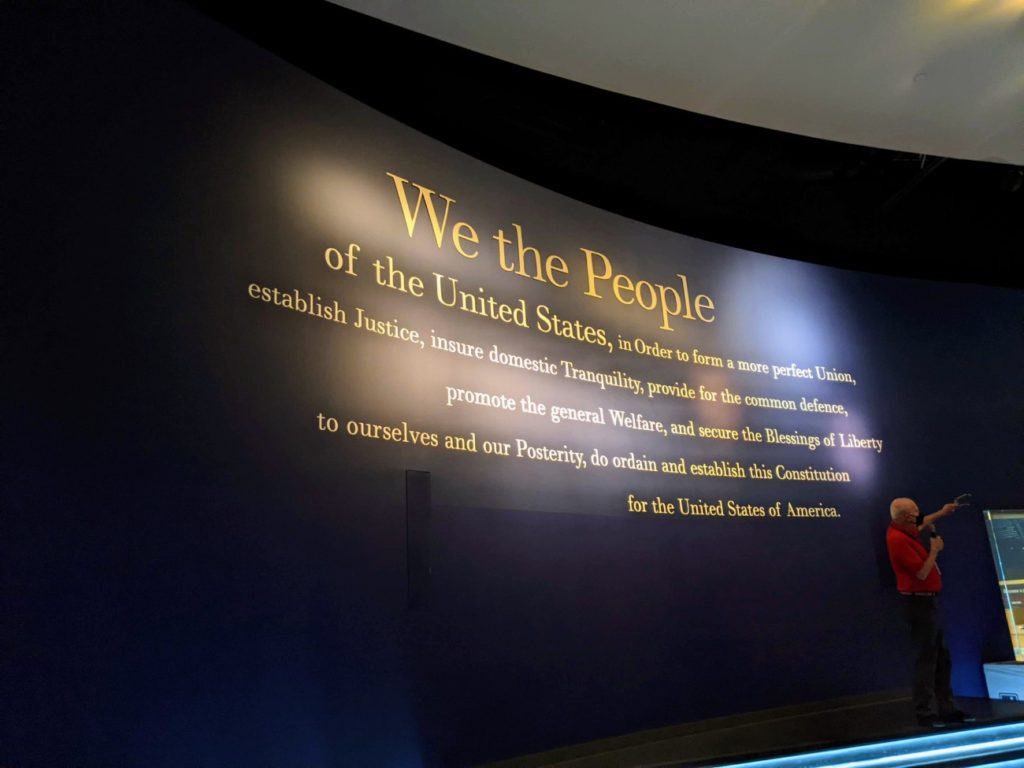
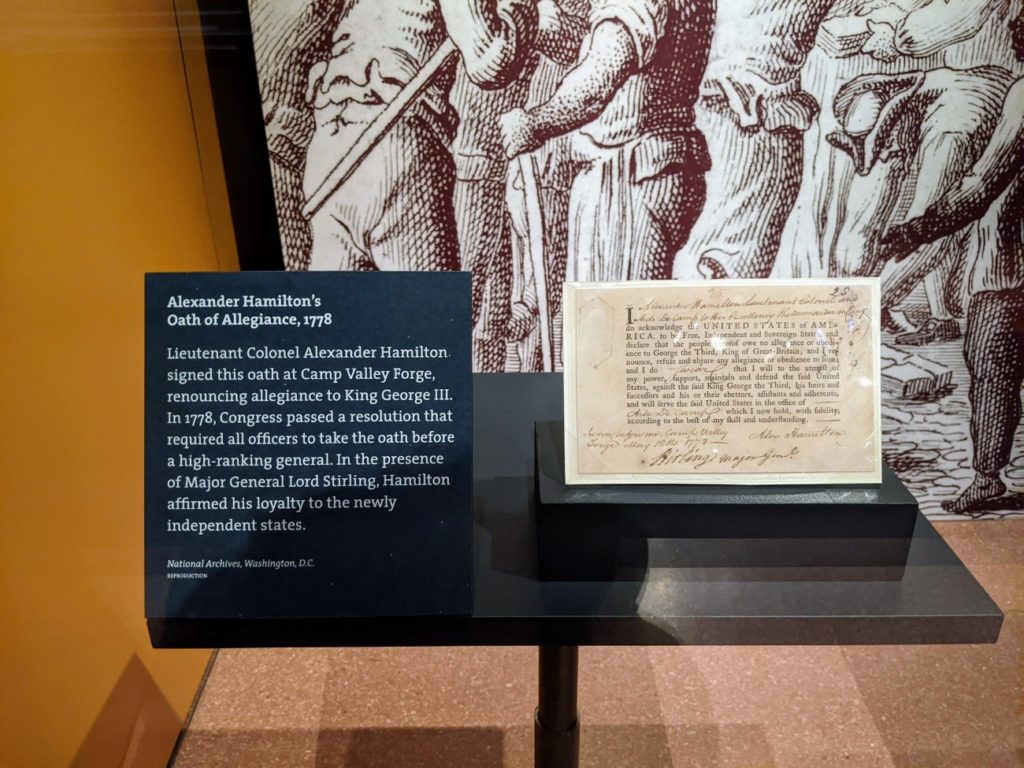
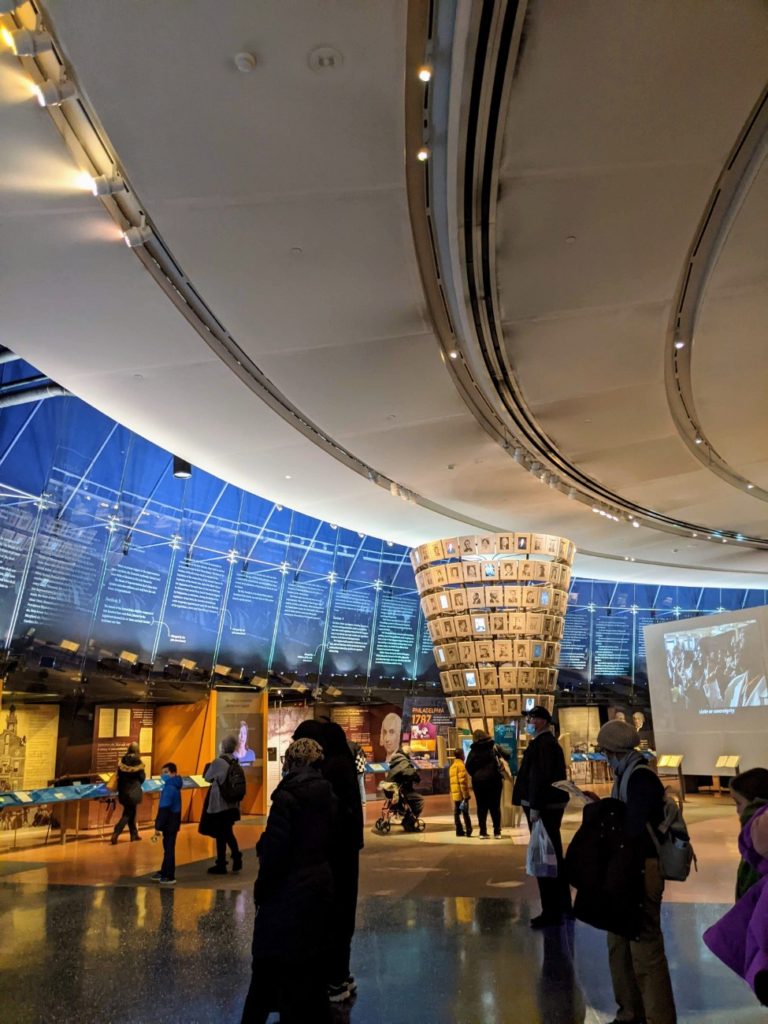
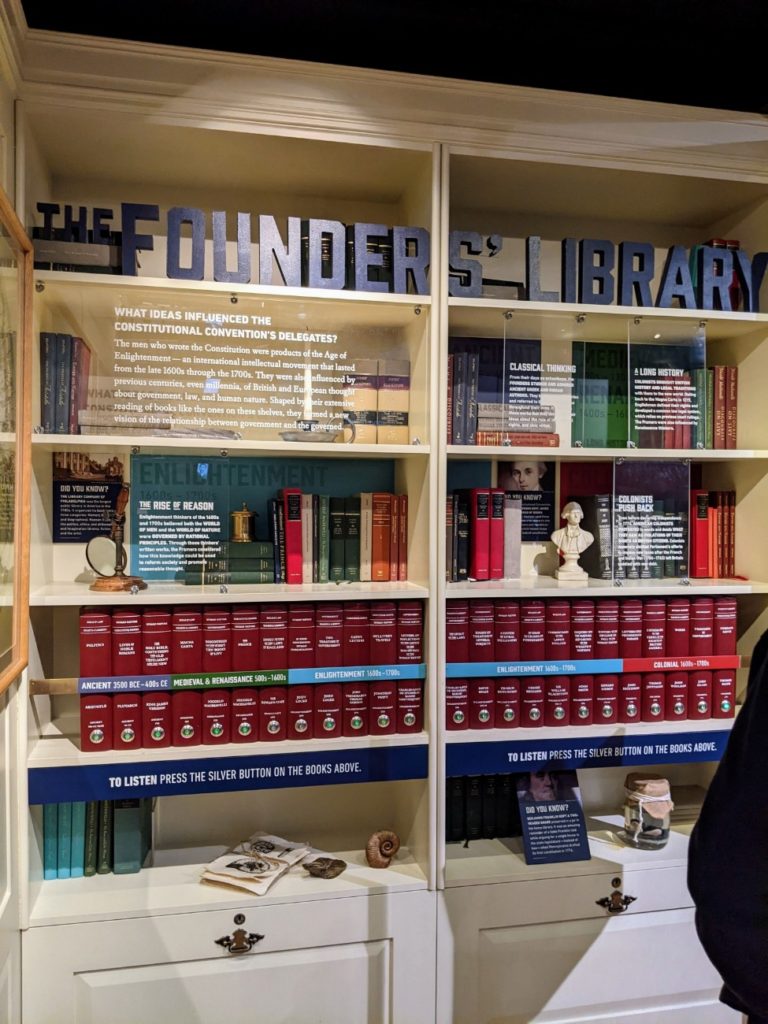
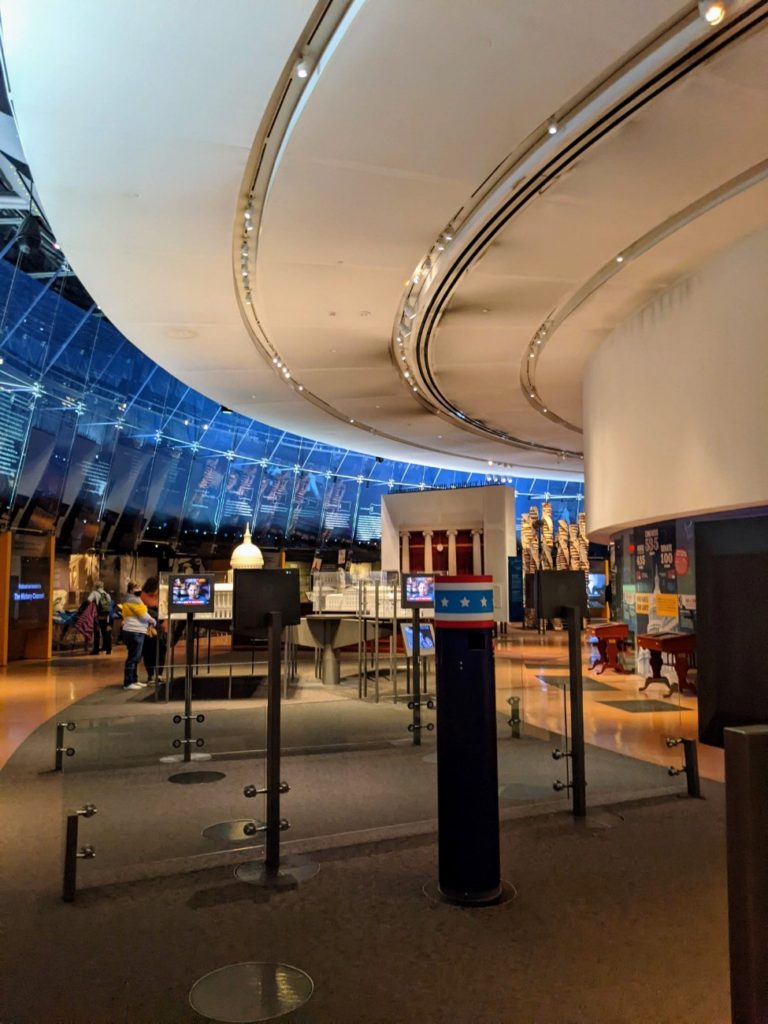
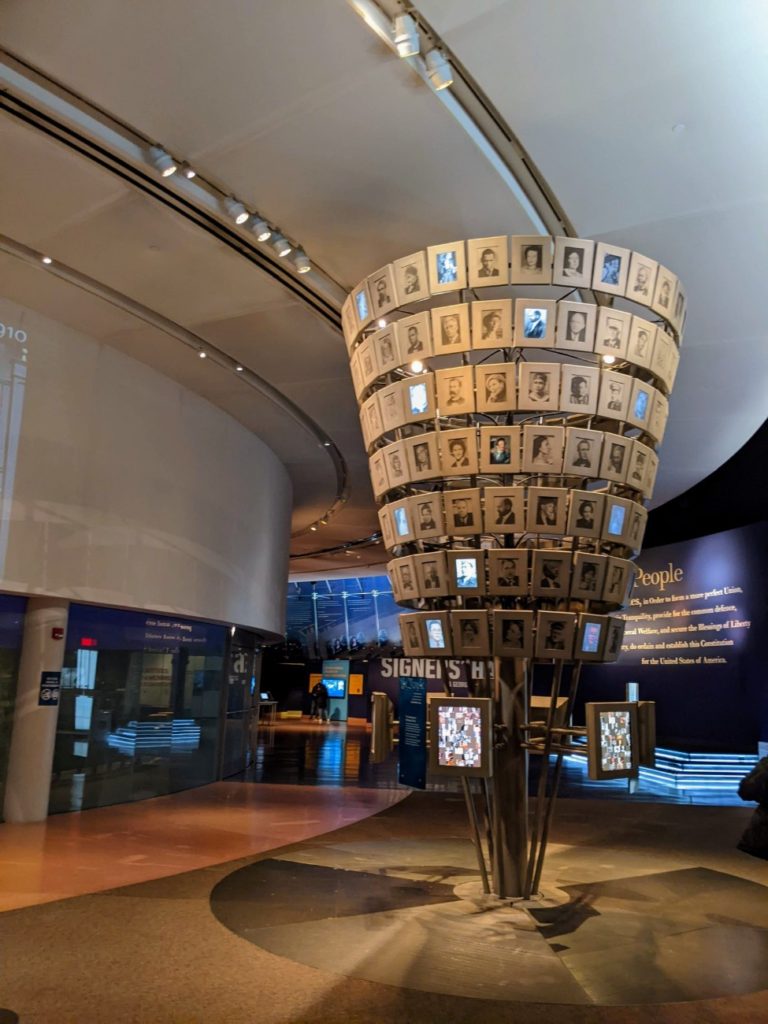
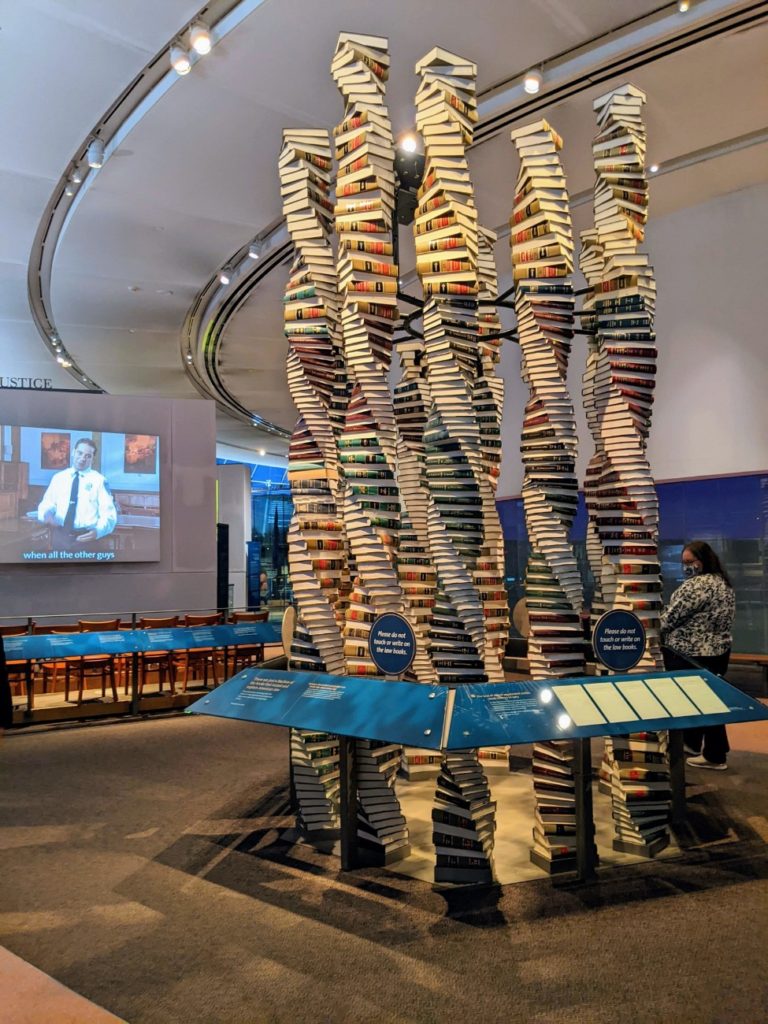
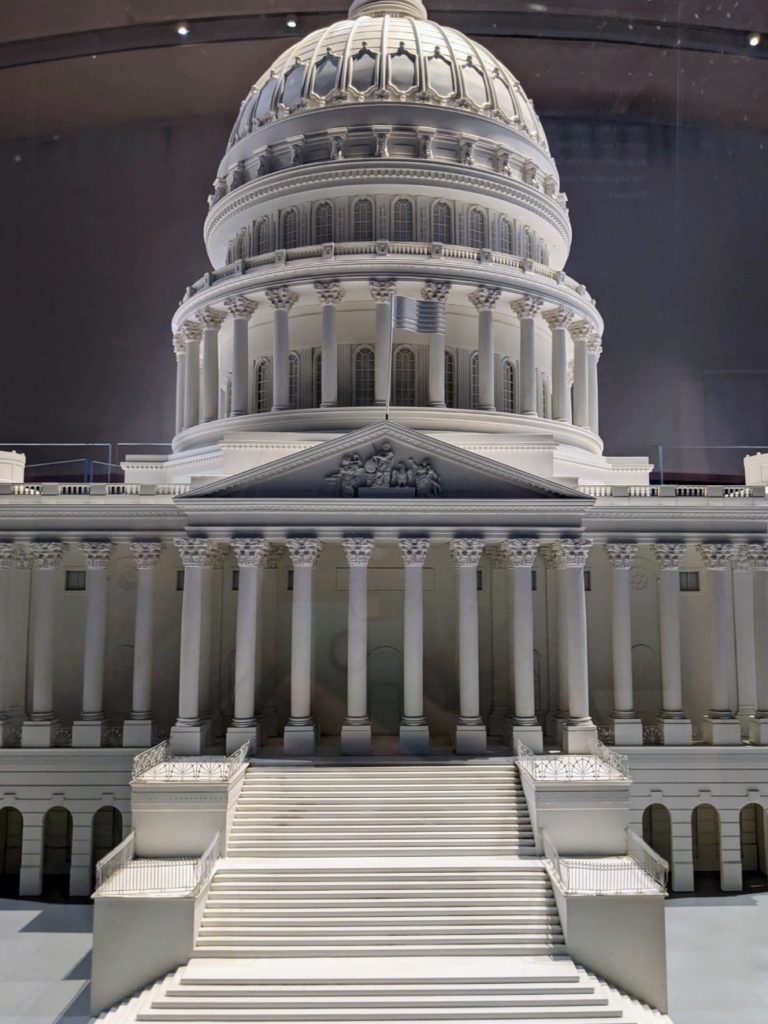
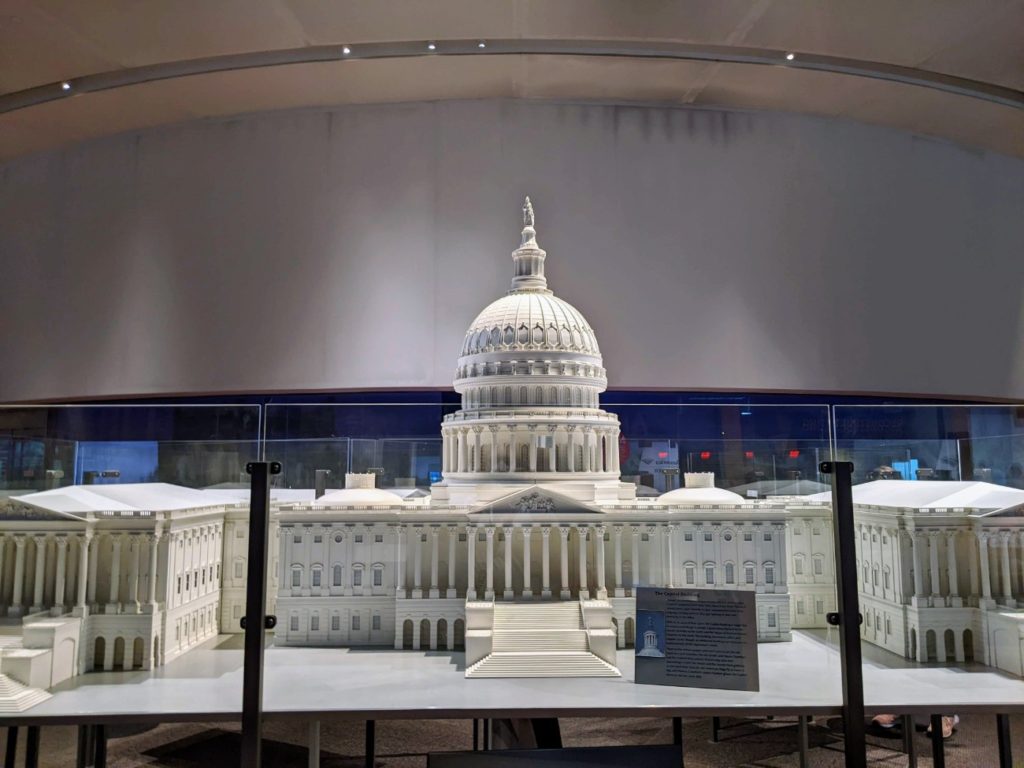
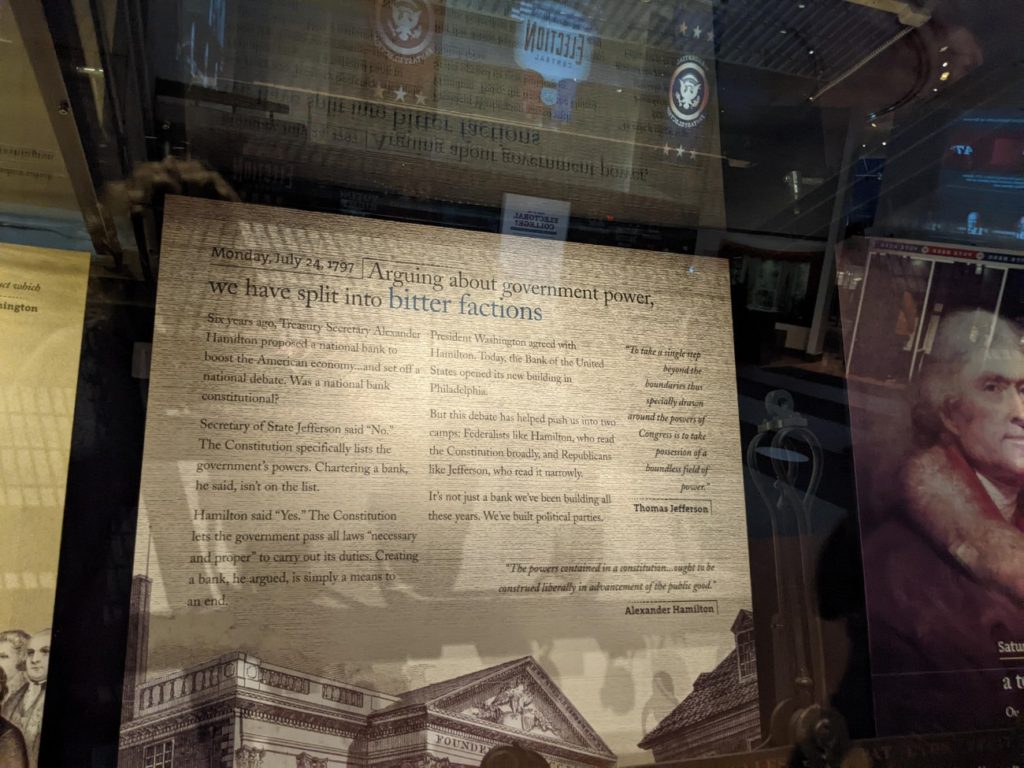
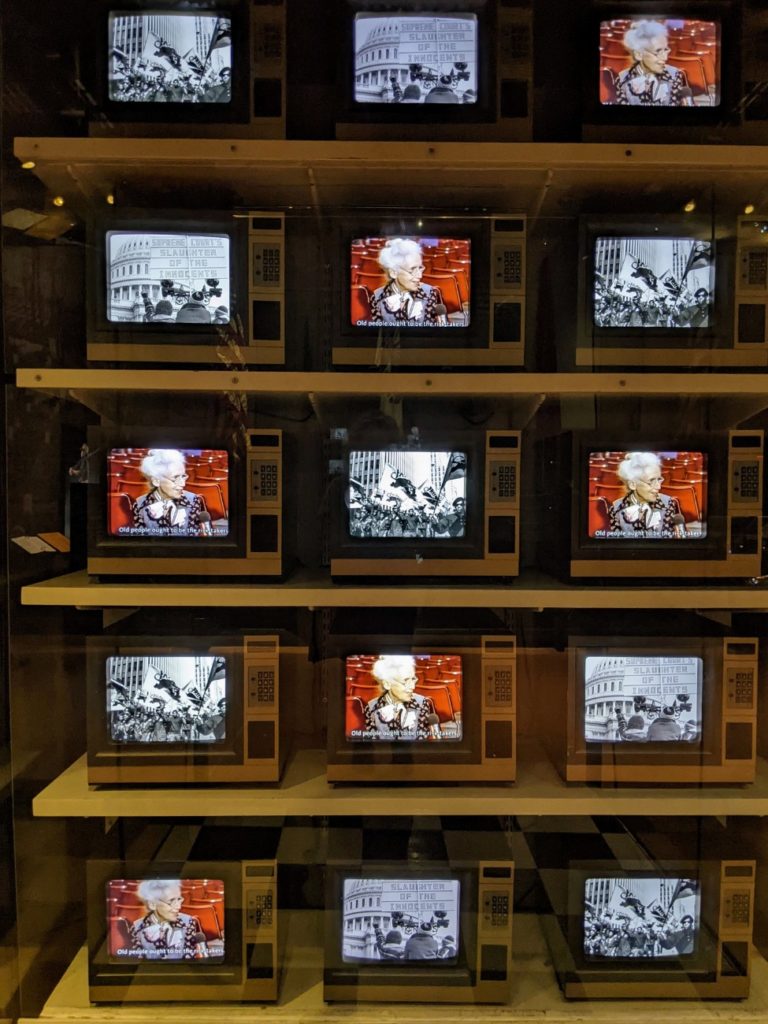
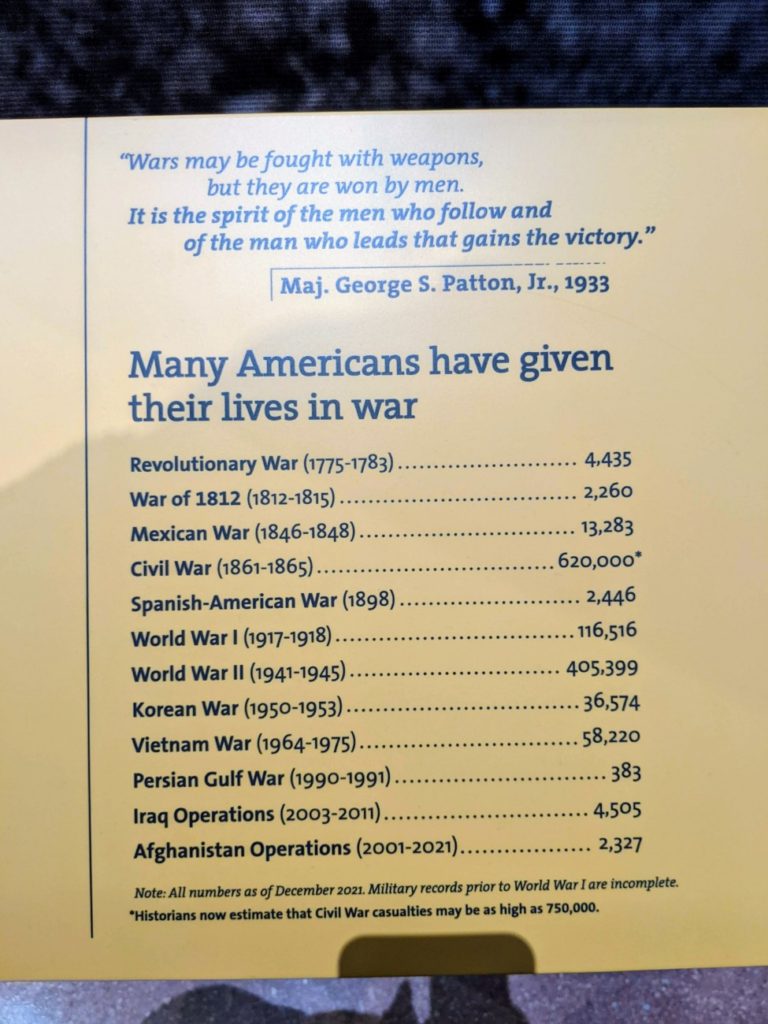
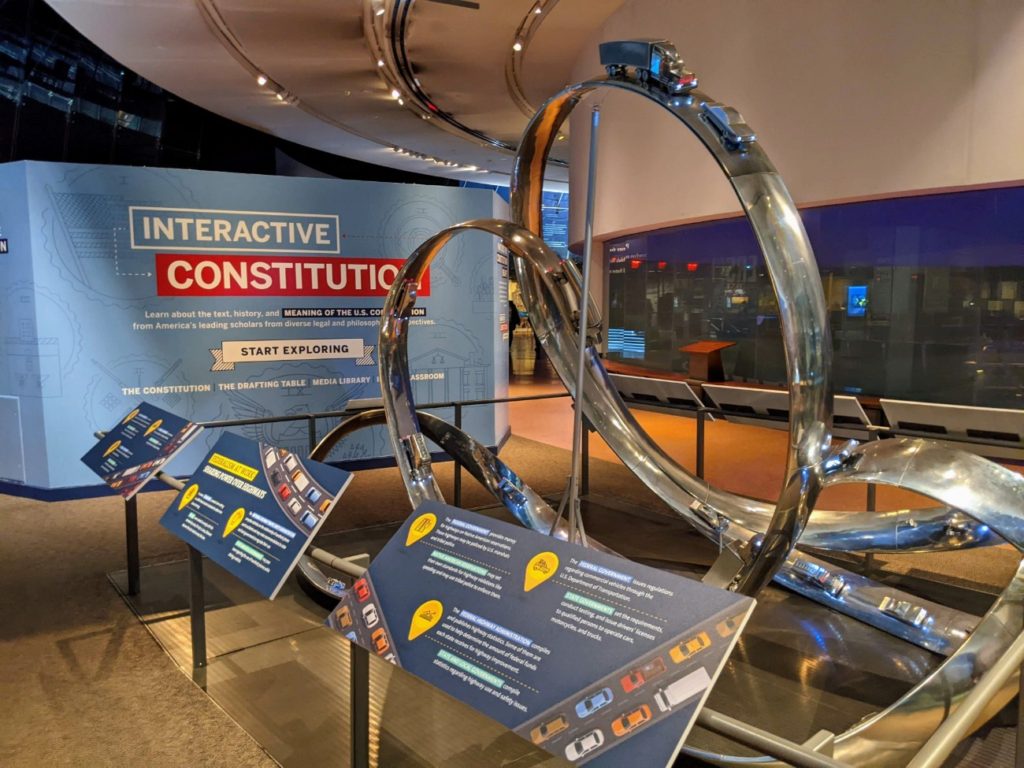
Signers’ Hall
When you get back to the “We The People” wall, you exit to an upper floor overlooking the lobby. You can walk around the perimeter to see the state’s flags better, but head to the left for the Signers’ Hall. This room contains life-sized bronze figures of all the signers of the Constitution. They stand around the room in casual conversational groups – or solo, as is the case for haughty Alexander Hamilton. Ben Franklin sits at a desk with several others. George Washington stands at the front of the room, under his own quote on the wall.
It’s fun to wander around and among these men who created our country, put faces to names, and pose for pictures.
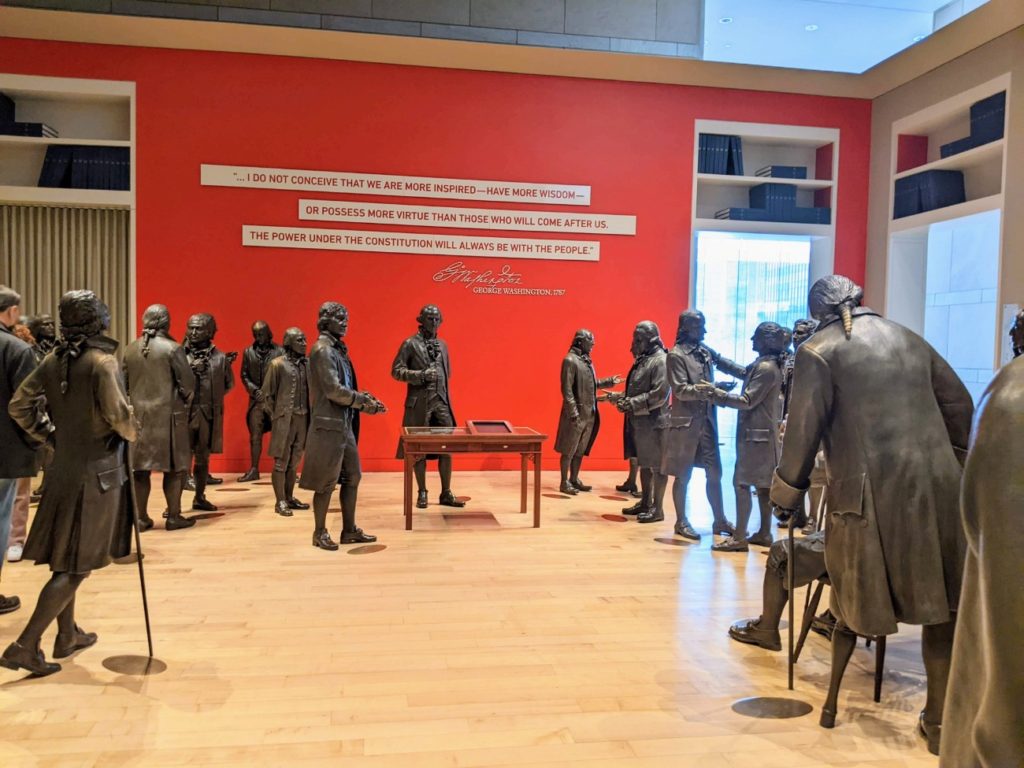
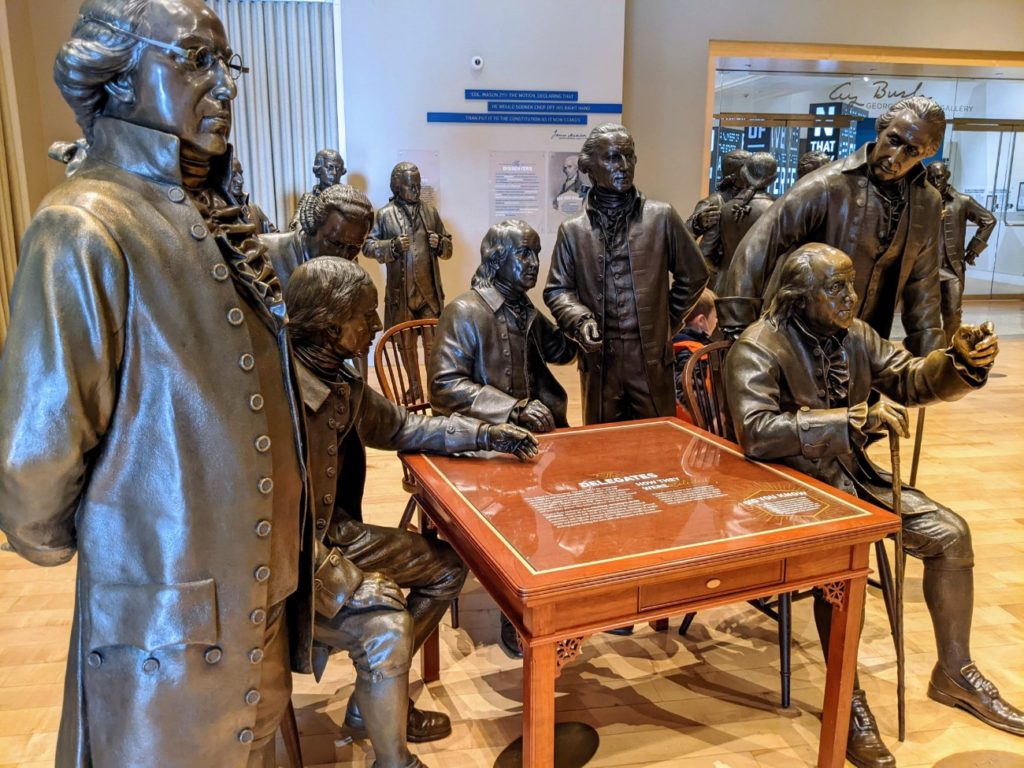
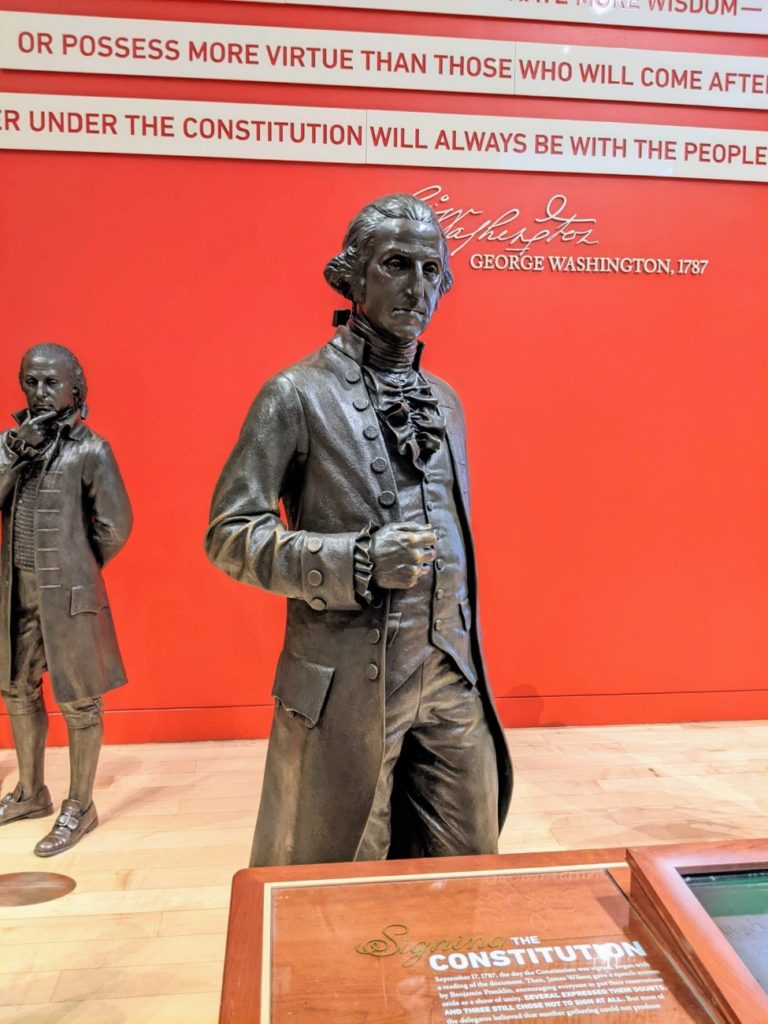
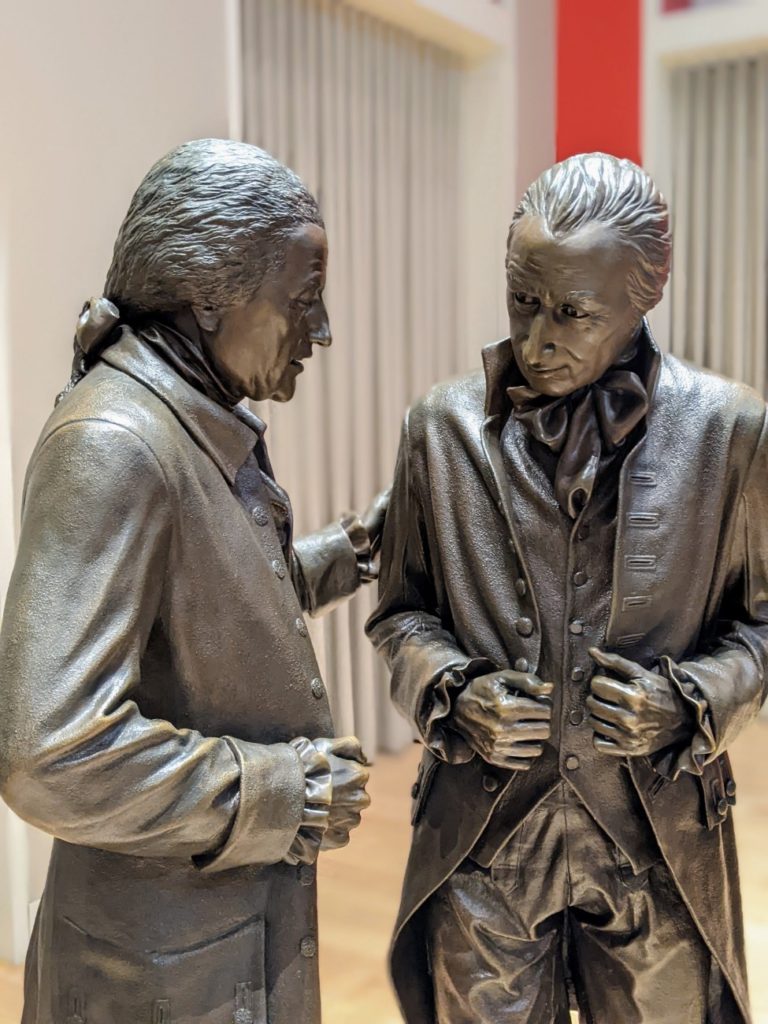
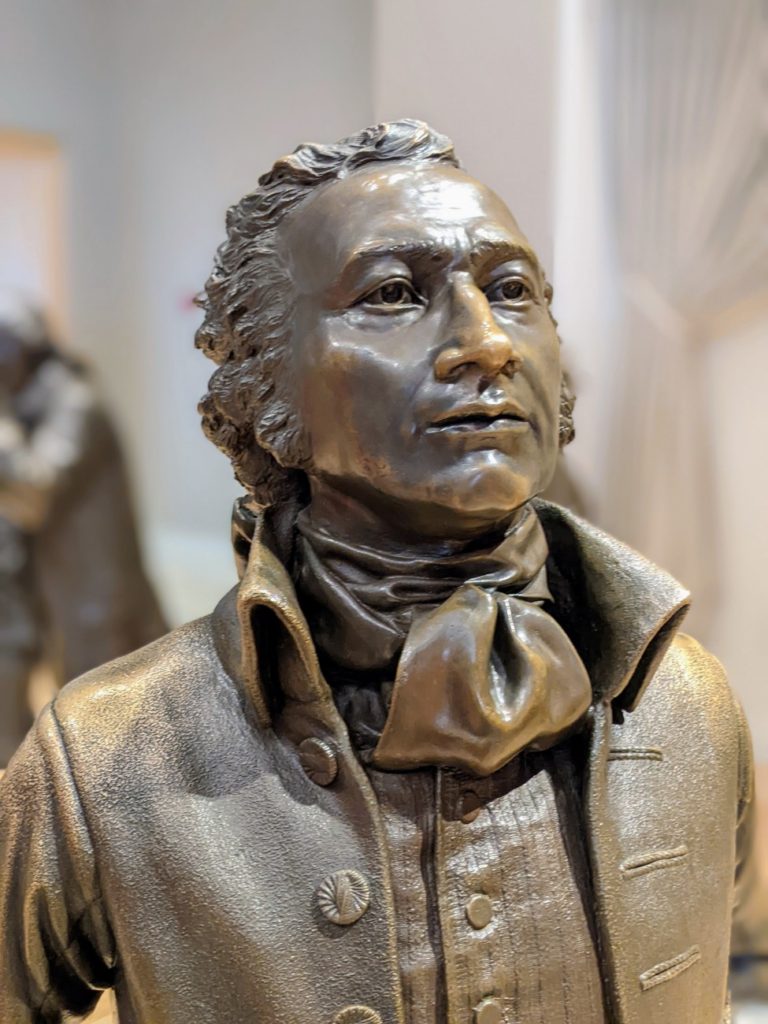
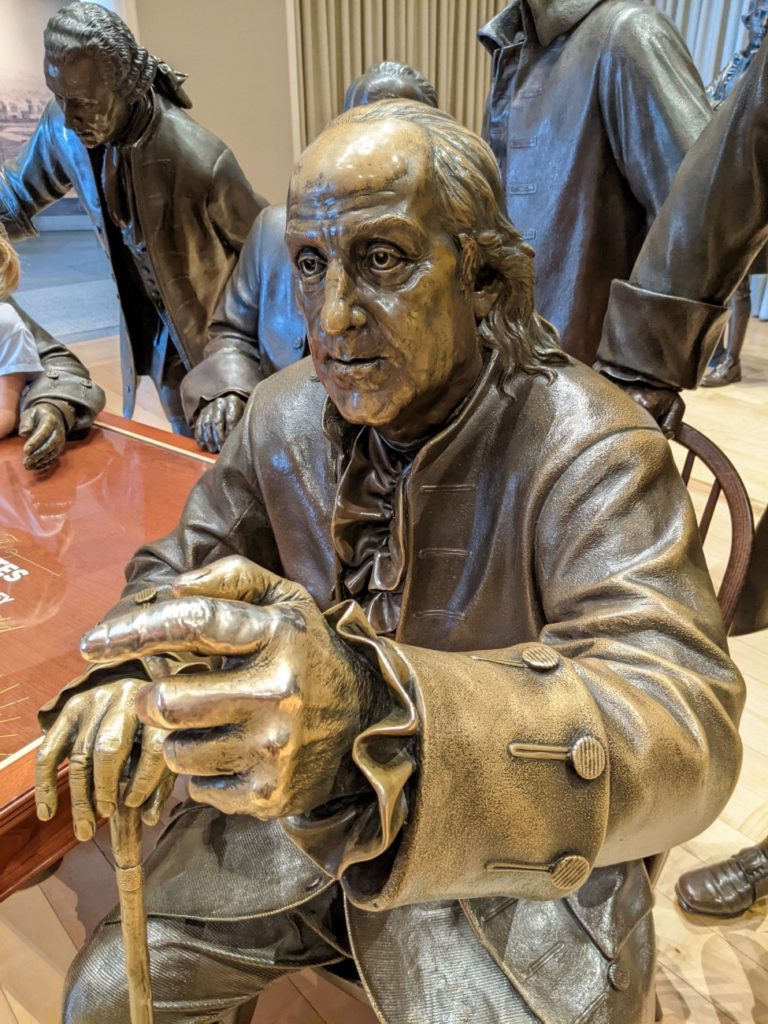
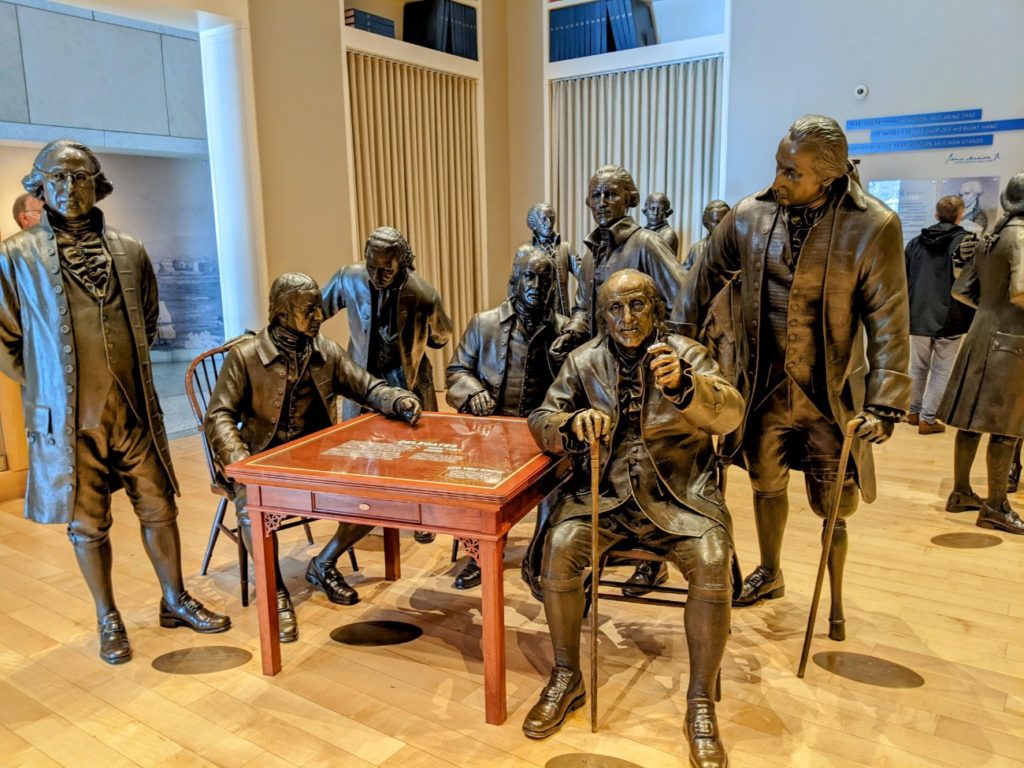
Constituting Liberty: From the Declaration to the Bill of Rights
In the back of the Signers’ Hall is a small room with early, rare editions of the Declaration of Independence, the Constitution, and the Bill of Rights. The Declaration is a first edition stone engraving, the Constitution is a rare first public printing, and the Bill of Rights is one of 12 rare originals. (Though sometimes that original is found in the New York Public Library – this copy is on rotation between Philadelphia and New York for the next 100 years.)
According to the National Constitution Center’s website, there is also an American Treasures gallery featuring five priceless first drafts of the Constitution, plus some handwritten notes. I confess I never saw this, so I’m not sure where it’s located! Your mission, should you choose to accept it, is to find out where it is and report back! It might not be entirely my fault that I missed it. Apparently, it goes dark sometimes to preserve the fragile paper.
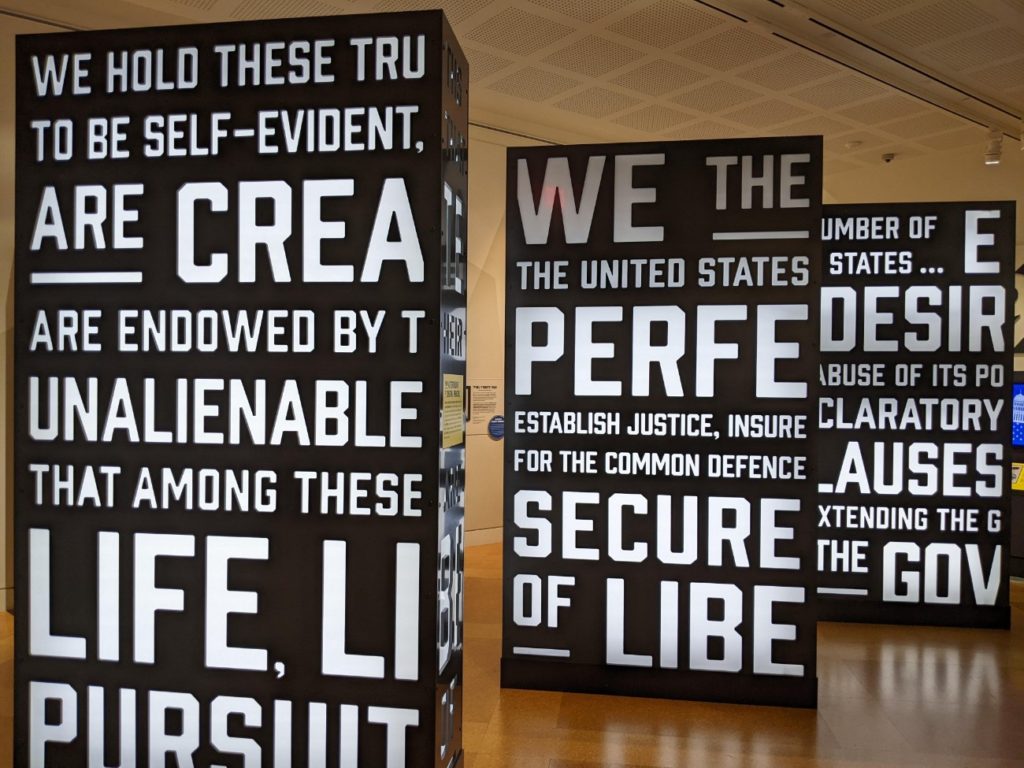
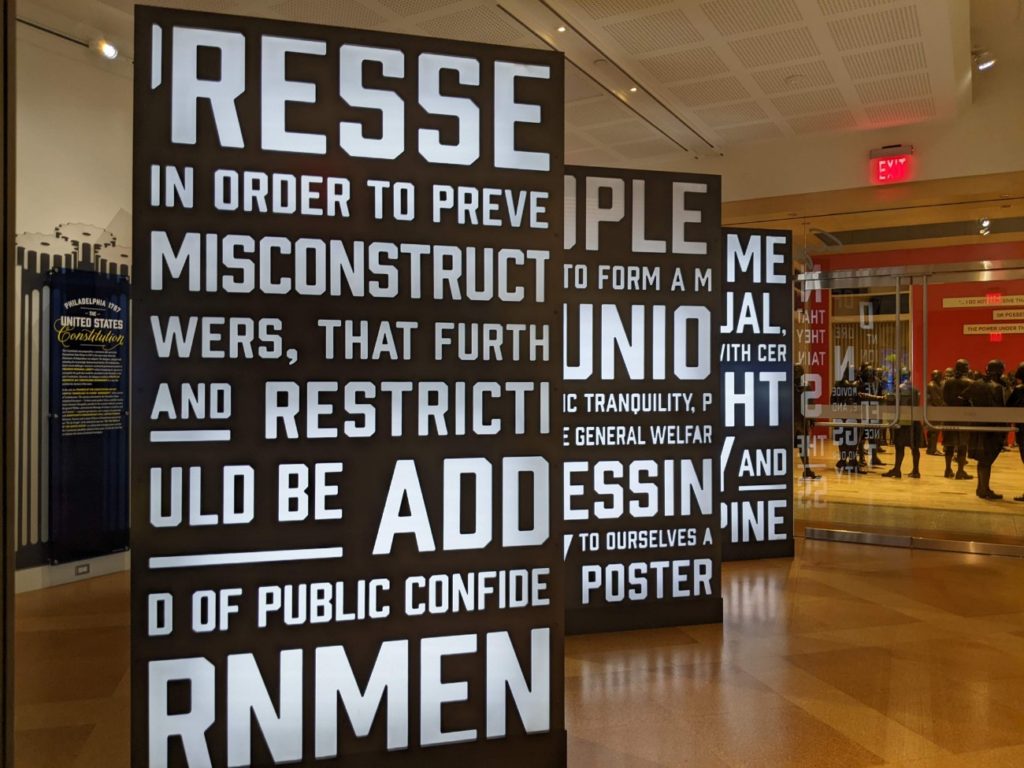
Civil War and Reconstruction: The Battle for Freedom and Equality
Downstairs are the two newest galleries. The first is on Civil War and Reconstruction, that brief 12 years after the U.S. Civil War but before Jim Crow laws were enacted. Former black slaves filled public offices from local government all the way up to Congress before white folk decided they didn’t like that too much and created basically slavery 2.0.
This exhibit is the only time I’ve ever seen an actual carpetbag (re: carpetbagger – northerners who exploited the ruined south post Civil War) and an odd-looking early Ku Klux Klan uniform.
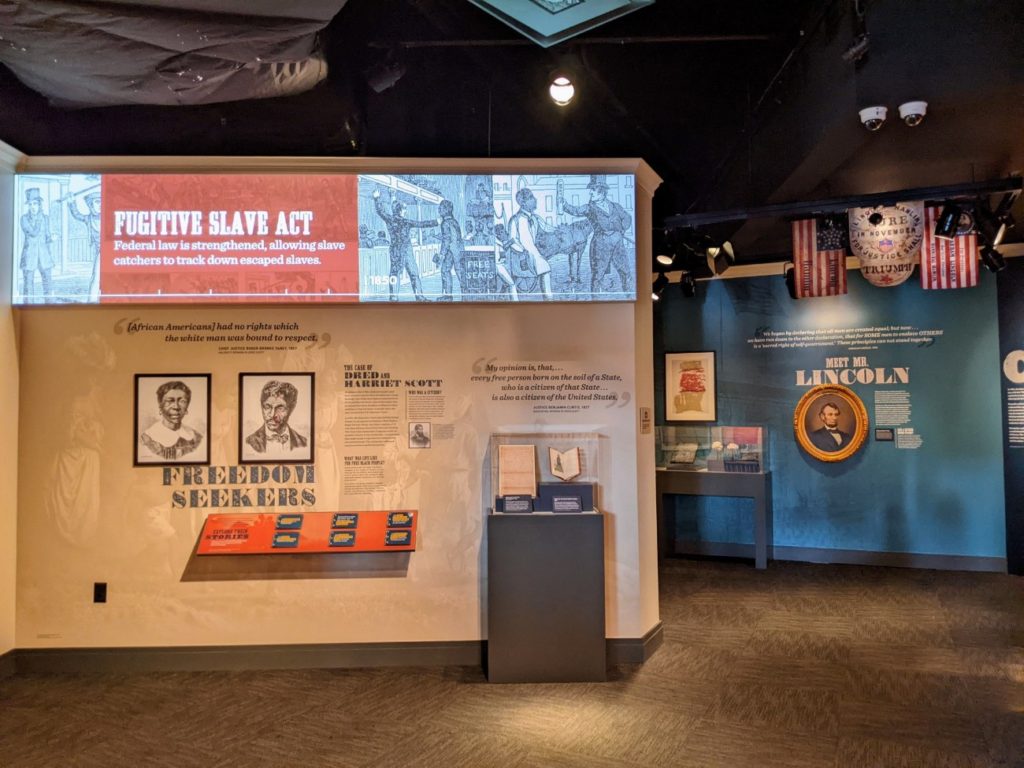
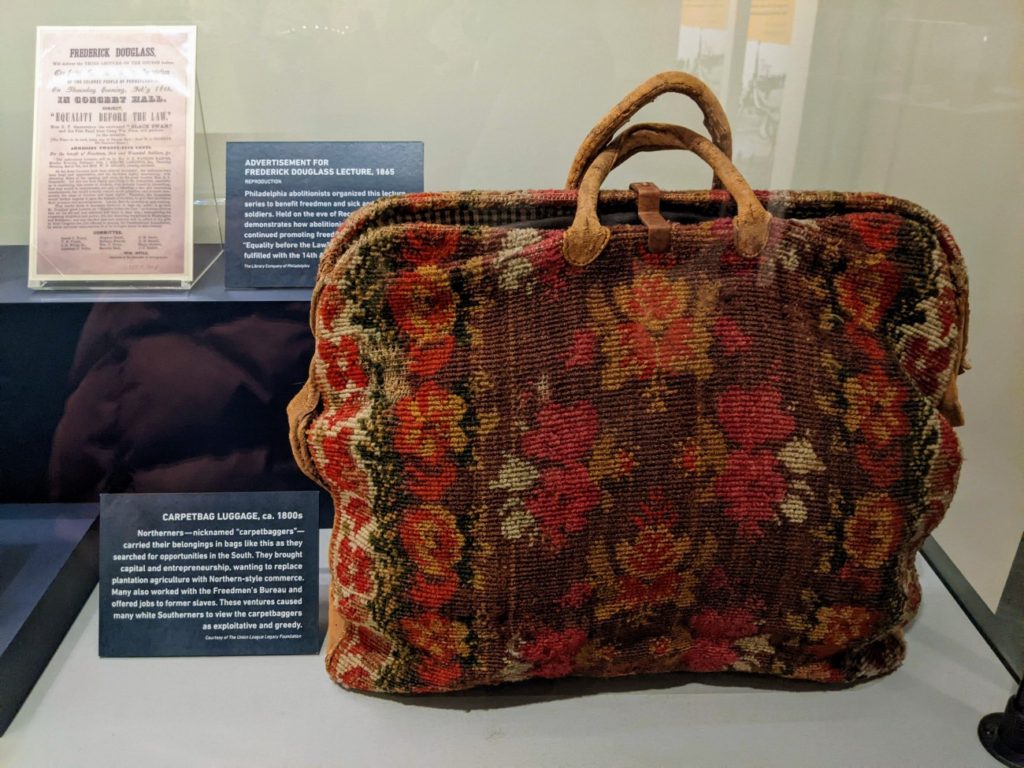
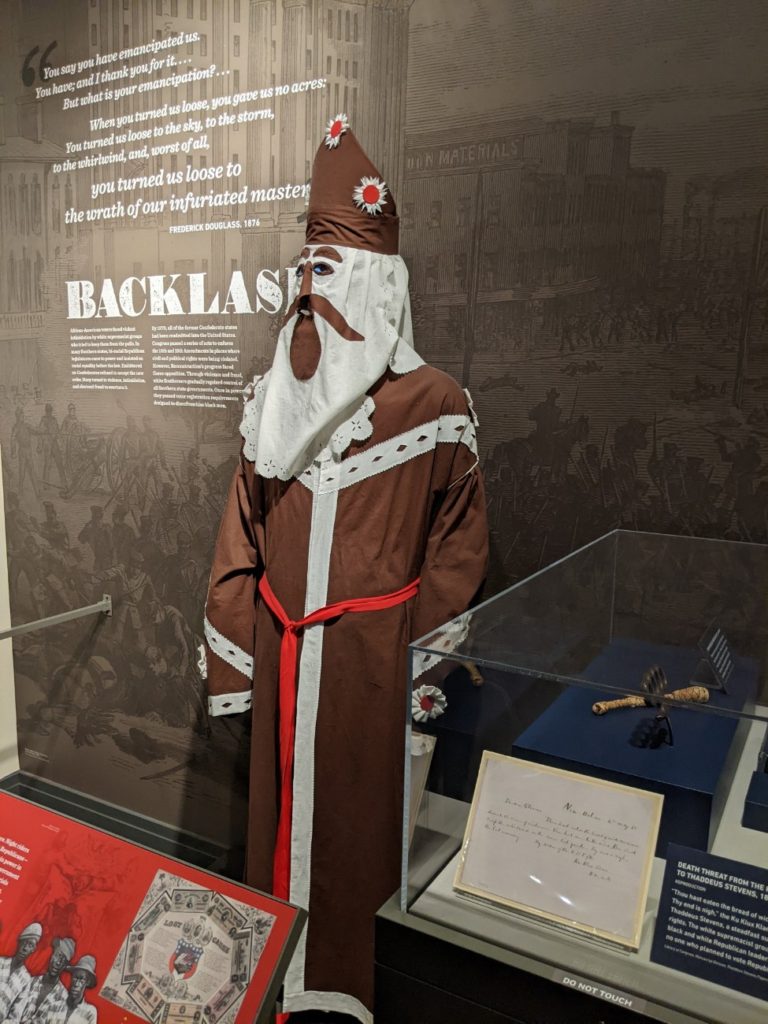
The 19th Amendment: How Women Won the Vote
The second new exhibit is behind the Reconstruction gallery. When you exit Reconstruction, head left for a new space on the 19th amendment to the Bill of Rights and how women won the right to vote. I’ve been through a few 19th amendment museum galleries before, and one thing that caught my attention here was new information to me. The final vote to ratify came down to my home state of Tennessee when one young representative got a call from his mother to “be a good boy” and vote in favor. His single vote put it over the line and women were finally allowed to vote in 1920.
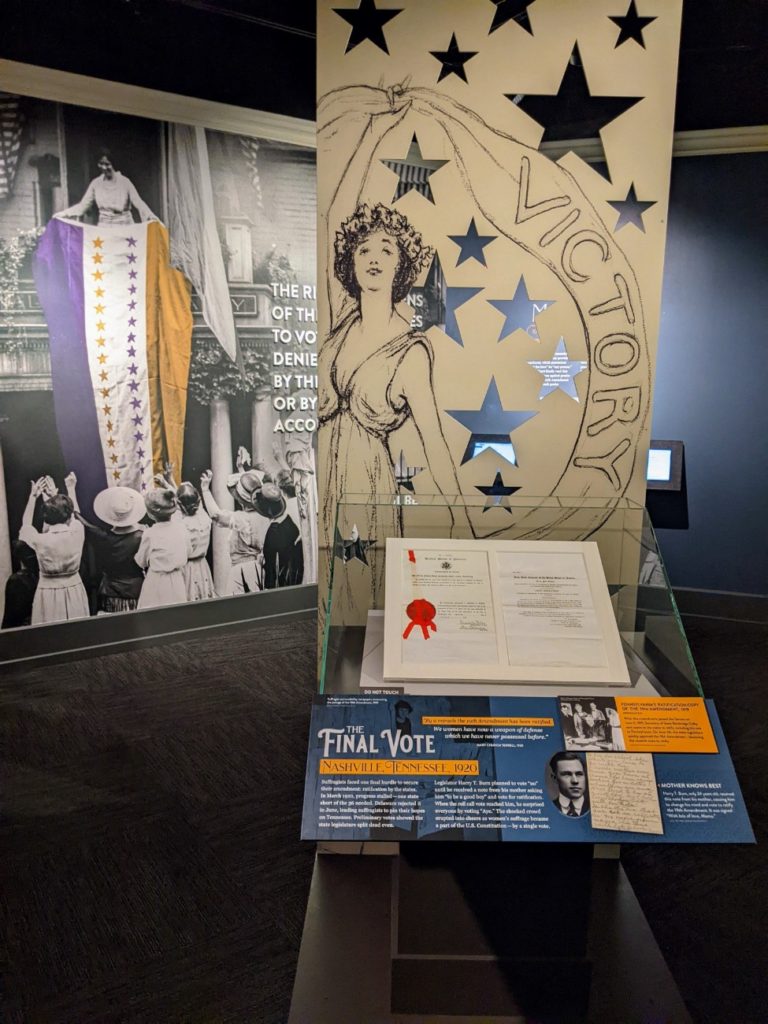
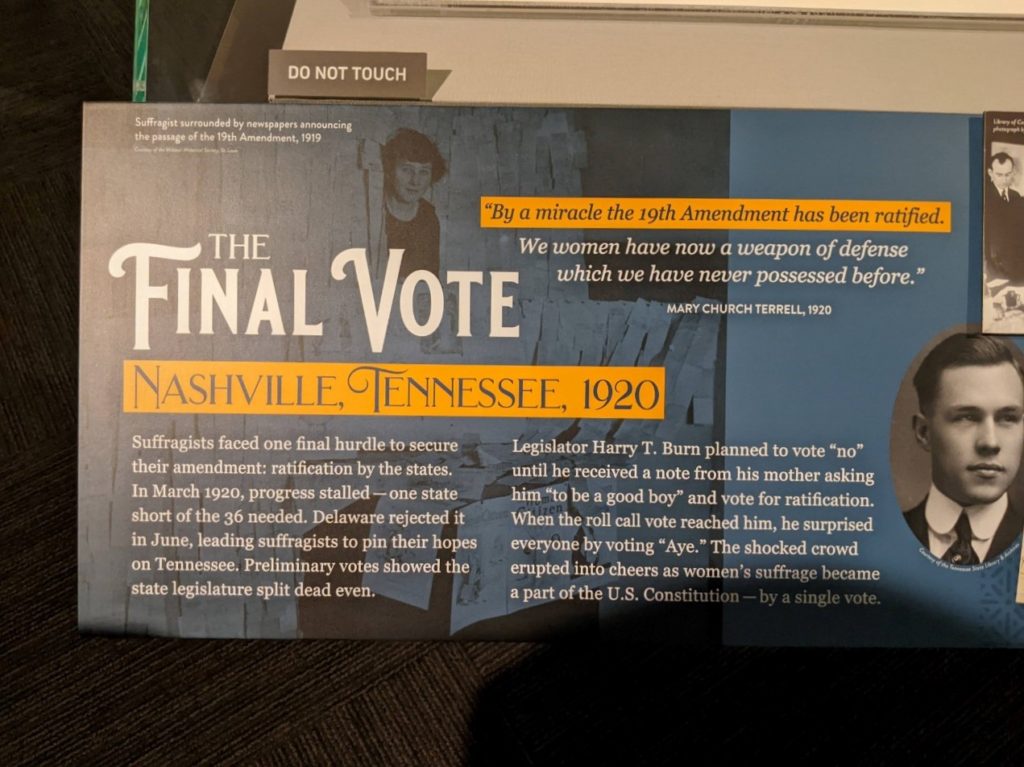
Admission & Hours
I happened to visit the National Constitution Center on a free day. I heard about it from the park ranger at the Liberty Bell Center. Usually, it costs $14.50 for adults, $11 for youth 6-18, and free for ages 5 and under. College students with ID and seniors 65+ get in for $13. Active military members with ID are free. You can also buy an annual membership for between $50 and $500.
Currently, the National Constitution Center is open Wednesday-Sunday, 10 am-5 pm.
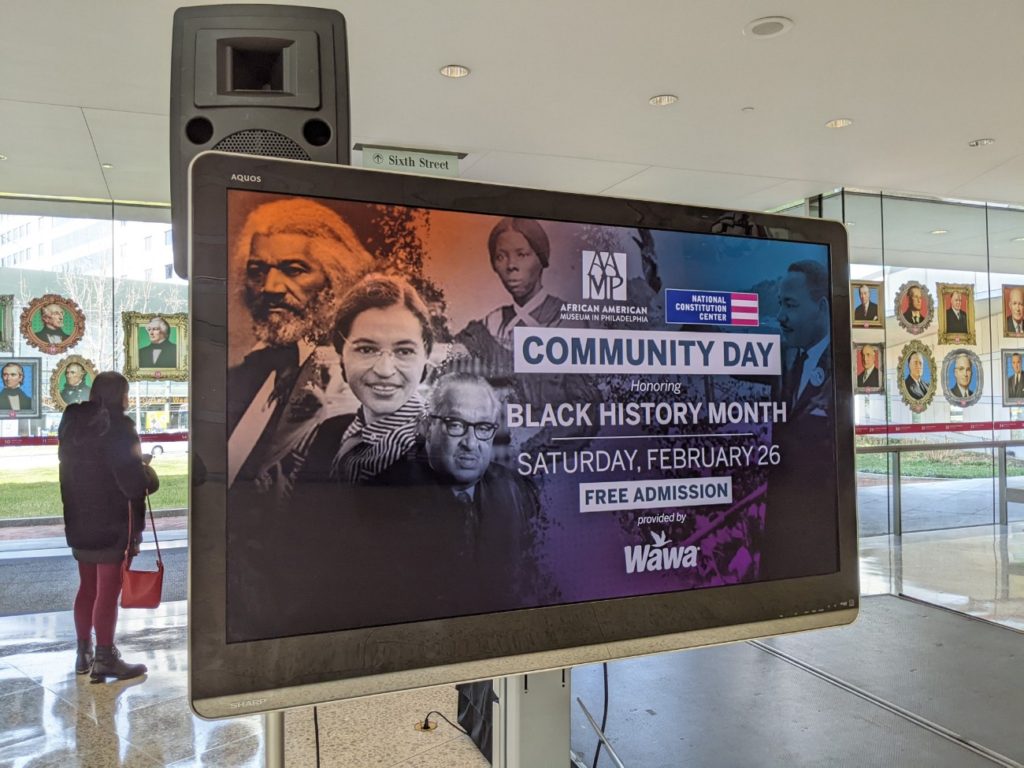
Food & Parking
Parking in downtown Philadelphia is notoriously difficult and expensive. Luckily, there is underground parking right next door under the Liberty Visitor Center. It has rates that are as comparable as anywhere. Otherwise, there are plenty of other garages and street parking nearby.
Outside the National Constitution Center, there are public bathrooms and a museum cafe. None of these were open during my late-February visit, but I’m sure they’re open when it’s busier (and warmer.) Otherwise, there are many dining options around, from a Wawa not too far away to plenty of fine dining. I walked 6 blocks down Arch Street to Reading Terminal Market, my favorite place for solo dining in Philadelphia.
I sort of stumbled into the National Constitution Center just because it was free, but I’m glad I went! It’s really well done and the theater show alone is worth a visit. This museum should definitely be a part of your historic Philadelphia tour.
Be First to Comment